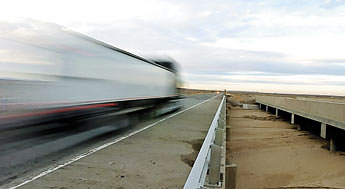|
Talks continue over widening of 491

A semi truck speeds past an unused bridge on U.S. 491 between Shiprock
and Newcomb on Friday evening. This new bridge has been sitting
next to 491 for more than a year in preparation for making US 491
four lanes from Tohatchi to Red Valley. [Photo by Matt Hinshaw/Independent]
By Zsombor Peter
Staff Writer
GALLUP — It was Jan. 10, 2005.
New Mexico Transportation Secretary Rhonda Fought and a delegation
of Navajo Nation officials were gathered a few miles south of Shiprock
to break ground on an ambitious state project to widen the notorious
68 miles of U.S. Highway 491 between Twin Lakes and Red Valley from
two lanes to four. Together they promised a new and improved 491
that would not only help spur economic development on the impoverished
reservation but save lives.
Two years later, all they have to show are a pair of disconnected
bridges a few dozen feet east of mile posts 66 and 68 where the
new northbound lanes will some day run.
No one ever expected it to be a quick job, or a cheap one. From
the start the state said the $125 million project would take at
least four years. Yet with all of two idle bridges they can do nothing
but look at, the rural communities strung out along the aging highway
are beginning to wonder what's taking so long.
According to the Transportation Department's latest news release
on the project now 10 months old state and tribal officials expect
construction to begin this spring. But neither the Navajo Nation's
lead attorney on the project nor the Transportation Department's
spokesman answered The Independent's numerous requests for further
comment.
That doesn't mean the state and tribe haven't been talking with
each other, however.
U.S. Highway 491 may be a federal route, and the state may be putting
up the cash to widen it. But the land the state plans to use is
the tribe's. They've been negotiating terms and conditions for months.
According to both state and tribal employees familiar with the talks,
however, the tribe has been having a hard time convincing the state
to meet some of its conditions.
"Right now the main thing that's going on is the right-of-way
acquisitions," said the Navajo Nation Transportation Department's
Tom Platero.
According to Arvin Trujillo, executive director of the tribe's Division
of Natural Resources, the state wants to pay a one-time fee for
the land. But the tribe, he said, is thinking of asking for recurring
fees at least it was at one point.
Fernando Trujillo, an assistant district engineer for the state,
said it still is.
"(Navajo Nation negotiators) haven't set their mind to it,"
he said, "but they have discussed it."
More precisely, he added, the tribe may want the fees distributed
over the course of several years, with the option to adjust them
later on.
None of them, however, know how much money they're talking about.
According to he and Platero, the tribe is also asking for preference
when the state starts hiring its work crews.
"You can give Indian preference, but to get it more specific
to say Navajo (preference), that's a little more tricky," Trujillo
said.
Federal law prohibits the state from restricting the applicant pool
to just Navajos, Trujillo said, but he's confident the state and
tribe will be able to work something out.
And as one of the only two things certain in life, as the saying
goes, taxes are another issue. According to Platero, the state is
saying no to the Navajo Nation's request that a three percent tribal
business activity tax be applied to the project.
For all their wrangling, the state and especially the tribe should
have good reason to get construction started as soon as possible.
As the main corridor connecting Interstate 40 to the Four Corners
area, a four-lane 491 can only help bring more business to the Navajo
Nation's eastern reaches. Fernando Trujillo said people are already
talking about building more restaurants and service stations along
the route in anticipation.
"Having a four-lane highway along the reservation helps us
in advancing economic development," Arvin Trujillo said, "but
the main issue we're looking at is safety."
According to data collected by the University of New Mexico, Highway
491 witnessed 640 crashes involving 38 deaths between 2000 and 2004.
While there's no good reason to believe those numbers make the route
more dangerous than any other, it hasn't stopped locals from believing
it is. Being numbered 666, before Gov. Bill Richardson changed that
in 2003 didn't help.
"The flow of traffic is increasing every day," said Carol
Bitsoi, chapter coordinator for the tiny community of Sheepsprings,
which sits on Highway 491 just between from Gallup and Shiprock.
But with only two lanes to handle it all, she considers the route
a certified "health hazard."
"Four lanes would probably help eliminate some of the problem,"
she said.
According to material on the state's Web site, the project is slated
for completion in the spring of 2009, a little over two years from
now. Assuming no major complications, Fernando Trujillo believes
it's still within reach.
|
Weekend
January 20, 2007
Selected
Stories:
Talks continue
over widening of 491
Funds frozen;
Discretionary account being abused, tribal officials say
'Brainteasers'
on exhibit at NMSU-G
Dulcimer
musician to perform Wednesday; Concert at UNM-Gallup
Spiritual
Perspectives; 'Stretch your spirit' with visiting Christian scholars
Deaths
|



